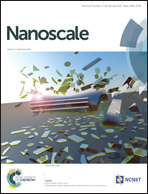Topologically protected Dirac plasmons and their evolution across the quantum phase transition in a (Bi1−xInx)2Se3 topological insulator†
Abstract
A 3D Topological Insulator (TI) is an intrinsically stratified electronic material characterized by an insulating bulk and Dirac free electrons at the interface with vacuum or another dielectric. In this paper, we investigate, through terahertz (THz) spectroscopy, the plasmon excitation of Dirac electrons on thin films of (Bi1−xInx)2Se3 TI patterned in the form of a micro-ribbon array, across a Quantum Phase Transition (QPT) from the topological to a trivial insulating phase. The latter is achieved by In doping onto the Bi-site and is characterized by massive electrons at the surface. While the plasmon frequency is nearly independent of In content, the plasmon width undergoes a sudden broadening across the QPT, perfectly mirroring the single particle (free electron) behavior as measured on the same films. This strongly suggests that the topological protection from backscattering characterizing Dirac electrons in the topological phase extends also to their plasmon excitations.


 Please wait while we load your content...
Please wait while we load your content...